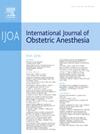Racial health disparities in severe maternal morbidity before and after implementation of an enhanced recovery after cesarean delivery protocol: a retrospective observational study at two NYC hospitals (2016–2020)
IF 2.6
3区 医学
Q2 ANESTHESIOLOGY
引用次数: 0
Abstract
Background
Enhanced recovery after cesarean delivery (ERAC) is an evidence-based pathway that aims to improve the quality of care for all patients. Standardization of care has been seen as a tool to promote equality and equity. Our goal was to evaluate racial differences in severe maternal morbidity (SMM) among patients before and after implementation of an ERAC program.
Methods
A retrospective study was performed among cesarean delivery patients pre- and post-ERAC implementation at two large academic hospitals in New York City from October 2016 to September 2020. Logistic regression models were created to compare peripartum SMM complications pre-ERAC, post-ERAC, and overall, by race.
Results
The sample consisted of 7,812 cesarean delivery patients, of which 4,640 were pre-ERAC (59.4%) and 3172 were post-ERAC (40.6%). Within the overall population, Black (aOR 1.57, 95% CI 1.07 to 2.28; P=0.018) and Asian (aOR 1.61, 95% CI 1.20 to 2.14; P=0.001) patients had higher odds of SMM compared to white patients. Pre-ERAC, Black (aOR 1.92, 95% CI 1.16 to 3.14; P=0.010) and Asian patients (aOR 1.86, 95% CI 1.26 to 2.74; P=0.002) had higher odds of SMM relative to white patients. Post-ERAC, this relationship was no longer statistically significant [Black (aOR 1.13, 95% CI 0.61 to 2.01; P=0.69) and Asian (aOR 1.39, 95% CI 0.88 to 2.17; P=0.15)].
Conclusion
Implementation of the ERAC protocol improved SMM outcomes by race. Standardization of practices in ERAC protocols can help address disparities by reducing variations in obstetrical care.
求助全文
约1分钟内获得全文
求助全文
来源期刊
CiteScore
4.70
自引率
7.10%
发文量
285
审稿时长
58 days
期刊介绍:
The International Journal of Obstetric Anesthesia is the only journal publishing original articles devoted exclusively to obstetric anesthesia and bringing together all three of its principal components; anesthesia care for operative delivery and the perioperative period, pain relief in labour and care of the critically ill obstetric patient.
• Original research (both clinical and laboratory), short reports and case reports will be considered.
• The journal also publishes invited review articles and debates on topical and controversial subjects in the area of obstetric anesthesia.
• Articles on related topics such as perinatal physiology and pharmacology and all subjects of importance to obstetric anaesthetists/anesthesiologists are also welcome.
The journal is peer-reviewed by international experts. Scholarship is stressed to include the focus on discovery, application of knowledge across fields, and informing the medical community. Through the peer-review process, we hope to attest to the quality of scholarships and guide the Journal to extend and transform knowledge in this important and expanding area.

 求助内容:
求助内容: 应助结果提醒方式:
应助结果提醒方式:


